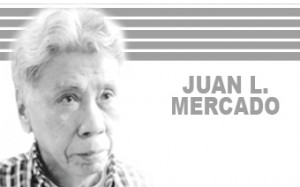 Here, All Souls’ Day is “two-pronged, bifurcated,†the wife said after we finished an early check of family tombs for this coming holiday.
Here, All Souls’ Day is “two-pronged, bifurcated,†the wife said after we finished an early check of family tombs for this coming holiday.
“What did you mean?†we asked. She went on: “And those plots will include ours, sooner rather than later.â€
“Half a world away, our granddaughters will join other kids in balmy Palo Alto, California, for trick-or-treat parties,†she mused. Alexia, 11, will dress up to resemble the Harry Potter series character Hermione, and Tai, 9, will pose as a ninja.
And in Ypsilanti, Michigan, our four-year-old grandson Lukas, has chosen to dress up as a ninja, but the turtle version. Shepherded by our son Francis and wife Tricia, he’ll trot with other kids, in the mid-autumn chill, to knock on neighbors’ doors for trick-or-treat handouts.
Two other grandchildren are here from years of living in their mother’s Sweden. Swedes bring flowers and light candles at family graves on the first day of winter.
In parts of Latin America, families sometimes leave food offerings for the departed on DÃa de los Difuntos. They say Halottak napja in Hungary and Yom el Maouta in Syria. In Bolivia, cakes are left for souls on the table and the room kept warm.
Halloween is a contraction of “All Hallows Eve.†In 1848, Irish immigrants brought those spooky costumes to the United States where it continues today as a fun-filled kids’ feast.
But reaching out to the departed goes back thousands of years. “It is a good and wholesome thought to pray for the dead,†declares the ancient Book of Maccabees.
By the year 998, the Benedictine abbot Odilo of Cluny had picked Nov. 2 for remembrance. This practice spread to other countries, including the Philippines.
The living aid the departed, the teaching went, by asceticism’s trio: prayer, sacrifice and alms. They’d help atone for past transgressions, and pave entry into the Beatific Vision.
“Lift us up, that we may see further, as one by one, You gather scattered families, from the distractions, strife and weariness of time, to the peace of eternity,†an ancient prayer goes.
The desire to “see further†echoes in jaded newsrooms with “de cajon†stories: Traffic jams, jostling crowds, crammed cemeteries “turned into two-day cities zapped by karaokes.â€
This October, Pope Francis canonized together the first married couple in modern times: Louis and Zelie Martin were the parents of St. Therese of Lisieux.
In her autobiography “The Story of A Soul,†St. Therese, often called “The Little Flower,†says her formative years were most shaped by her parents. After her dying mother received extreme unction, her father “took me in his arms†and had her kiss Zelie’s forehead.
They underscore the central—and stunning—reality remains of life beyond a handful of ashes.
“We Filipinos use the idiom ‘itaga mo sa bato’ to assert utmost confidence,†Pastor Lino Pantoja writes.
“Oh, that my words were engraved in rock forever,†the biblical figure Job wrote.
Words of Job’s primitive theology of the Resurrection proclaim: “I know that my Redeemer lives. And in the end, He will stand forth upon the earth. And after my skin shall have been destroyed, yet in my flesh I shall see God.â€
These words were written 2,500 years before Easter’s empty tomb. And in 1741, George Frideric Handel had worked it into his soaring oratorio that the world has never forgotten: “The Messiah.â€
Our grandchildren are the post-Vatican II generation. They never heard what echoed in the requiem services of our long-vanished youth: the “Dies Irae†(Day of Wrath) in plain chant.
“Tuba mirum spargens sonum/Per sepulchra regionum/Coget omnes ante thronum,†the choir would sing. My now-hazy freshman Latin translates that into: “Trumpets blare through sepulchers/calling all to appear before judgment’s throne.â€
Young and old, however, share the universal ache for assurance of what lies beyond the grave.
I recall writing the following much earlier:
“If only I could see him, for just a second, and know he’s all right, I’d be able to cope,†Seamus tells the priest blessing his son’s crumpled body, killed in an accident.
“I remembered Seamus’ comment†at a Mass for a student accident victim, writes Jesuit theologian Catalino Arevalo. “The boy’s classmates chose the Transfiguration for gospel reading. The one about Jesus going up to the mountain and changing into dazzling white, they suggested.
“It struck me, for the first time, that Jesus allowed his friends to see, ‘for just a second,’ what was beyond. Their reaction was strange: They did not want to leave the spot. It’s ‘wonderful for us to be here.’ But Jesus reminded them they had to go down the mountain.
“What if we could get some vision, ‘for just a second’? Or if we could, ‘for just a second,’ see people who’ve gone before us, in faith, especially those suddenly or tragically taken, in that place of light that is God’s promise?
“What if we, too, had some authentic extended experience of what ‘our eyes have not seen, nor our ears heard’ of what God prepared for those who are faithful?
“It is truly the better thing that an authentic extended experience is not given us—because we would not want to leave the spot. Better still, because there is still so much of the humdrum, the frustrating, the difficult for us to endure, and if possible, with courage, to build some small beginnings of the Kingdom which Jesus wanted to make our work in this world.â€
Whether in the dim catacombs off Rome’s Appian way, or in our garishly lighted cemeteries, All Souls Day speaks to us in Nobel Laureate Rabindranath Tagore’s poignant verse: “Death is not the extinguishing of life. It is putting out the lamp, because dawn has come.â€
Juan L. Mercado served as a communication officer for the Food and Agriculture Organization of the United Nations in Bangkok. Thereafter, he was posted in FAO headquarters in Rome, Italy, as attaché de cabinet. He wrote for the Inquirer as a regular columnist from February 2004 until December 2014.




Be First to Comment